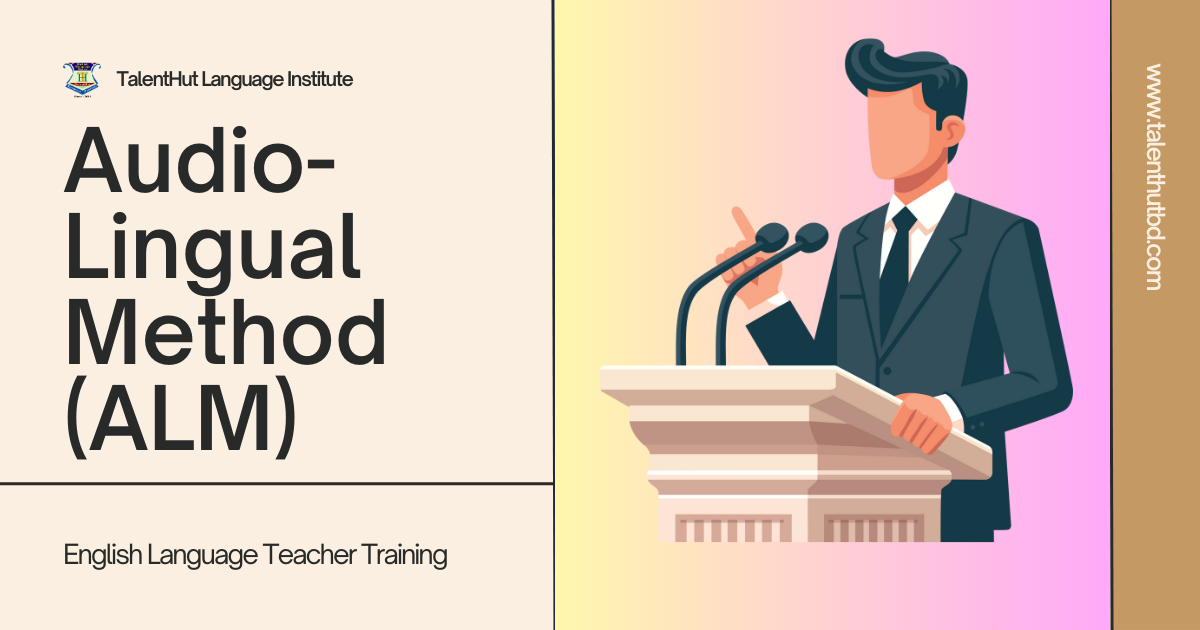The ALM (Audio-Lingual Method) in ELT: Teaching English to ESL Students
The Audio-Lingual Method (ALM) in Teaching English to ESL/EFL students
The Audio-Lingual Method (ALM) is a well-established approach in English Language Teaching (ELT), particularly for teaching English to speakers of other languages (ESL). Rooted in behaviourist theory, ALM emphasizes repetitive drills and pattern practice to reinforce language structures and pronunciation. This article will explore the principles of ALM, its practical applications, and how platforms like talenthut and talenthutbd can effectively use this method to teach English to ESL students, including preparation for standardized tests like IELTS.
Understanding the Audio-Lingual Method (ALM)
Overview: The Audio-Lingual Method focuses on listening and speaking skills through repetitive drills and mimicking. It aims to develop fluent oral communication by embedding correct language habits.
Key Features:
– Emphasis on listening and speaking over reading and writing.
– Use of repetition and drills to reinforce language patterns.
– Minimal use of the native language; focus on target language use.
– Structured around dialogues and pattern practice.
– Focus on correct pronunciation and intonation.
Practical Applications of the Audio-Lingual Method
1. Dialogues and Pattern Drills
Practical Application: At talenthut, ESL/ELT classes can begin with dialogues that introduce new vocabulary and grammatical structures. These dialogues can then be broken down into smaller chunks for repetitive drilling. For example, a dialogue about ordering food in a restaurant can be practised repeatedly, with students taking turns to play different roles. This helps internalize common phrases and sentence structures.
2. Repetition and Mimicry
Practical Application: Repetition is key in ALM. Talenthutbd can create audio resources where native speakers pronounce words and sentences, which students repeat. For instance, a lesson on past tense verbs can involve students repeating sentences like “I went to the market,” “She saw a movie,” and “They played soccer” multiple times until they achieve correct pronunciation and intonation.
3. Drill-Based Exercises
Practical Application: Drills are essential in reinforcing language patterns. TalentHut can design drill-based exercises that focus on specific grammar points. For example, substitution drills can be used where students replace certain words in a sentence to practice different structures. An exercise might involve changing “I am reading a book” to “He is reading a book” and “They are reading a book,” reinforcing subject-verb agreement and verb forms.
4. Use of Language Labs
Practical Application: Language labs equipped with audio tools can be highly effective for ALM. Talenthutbd can set up virtual language labs where students listen to recordings and practice speaking. These labs can include interactive exercises, such as responding to prompts or participating in simulated conversations. For instance, an exercise might involve listening to a question like “What did you do yesterday?” and responding with “I studied English,” practising both comprehension and speaking.
5. Pronunciation Practice
Practical Application: Correct pronunciation is a major focus of ALM. TalentHut can incorporate pronunciation drills into daily lessons. Teachers can use minimal pairs (words that differ by only one sound, like “ship” and “sheep”) to help students distinguish and produce sounds accurately. Students can listen to recordings of these pairs and practice saying them aloud until they achieve clarity.
6. Role-Playing Activities
Practical Application: Role-playing activities can make ALM more interactive and engaging. TalentHut can design role-plays based on real-life scenarios that students are likely to encounter. For example, a role-play about visiting a doctor can involve students practising phrases and sentences related to symptoms and treatments. This not only reinforces vocabulary but also helps students apply language skills in practical contexts.
7. Listening Comprehension
Practical Application: Listening comprehension is crucial in ALM. TalentHutbd can create listening activities where students listen to dialogues or monologues and answer questions based on what they hear. For IELTS preparation, this can include listening to sample test recordings and practising with similar materials. For example, students can listen to a recording of a conversation and then answer questions about the main ideas and specific details.
Conclusion
The Audio-Lingual Method remains a powerful tool in the arsenal of language teaching methodologies. Focusing on repetitive drills, pronunciation, and oral practice, helps students develop strong listening and speaking skills. Platforms like talenthut and talenthutbd can effectively incorporate ALM into their ESL/ELT programs to provide structured, engaging, and practical language learning experiences. Whether for everyday communication or standardized tests like IELTS, the Audio-Lingual Method equips students with the foundational skills necessary for proficient English usage.
For contact:
Email: [email protected]
WhatsApp: +8801611237732

